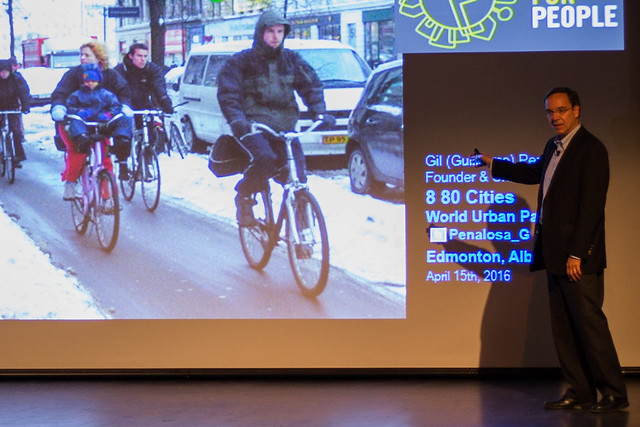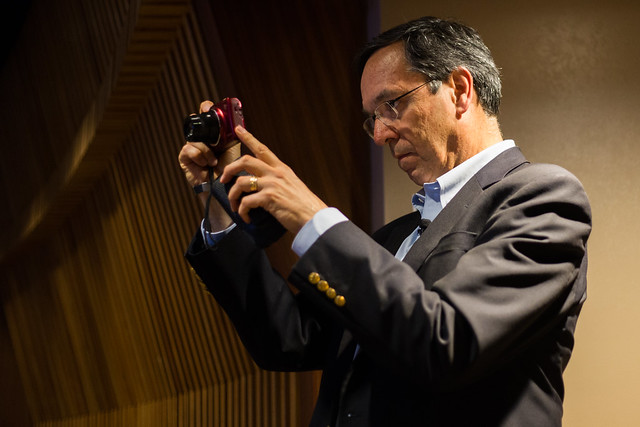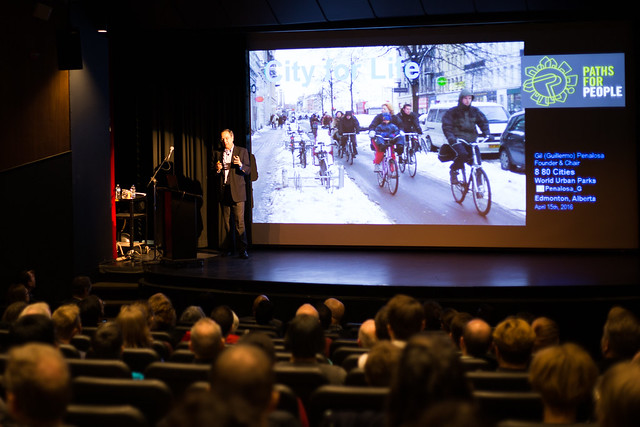Gil Penalosa was in Edmonton tonight to share his thoughts on building successful cities, healthy communities, and happier people. Gil is the founder of Toronto-based 8 80 Cities, chair of the board of World Urban Parks, consultant with Danish firm Gehl Architects, and former Commissioner of Parks & Recreation in Bogota where he led a transformation of that city’s park system and implemented the “new Ciclovia” program that sees nearly 1.5 million people walk, run, skate, and cycle along Bogota’s roads every Sunday. He spent about 90 minutes with a theatre full of people all passionate about making Edmonton a better place for pedestrians and cyclists and ultimately, for everyone.
He started out addressing winter. We’ve had an unusually mild one this year, but normally it’s all Edmontonians talk about. “It’s a mental problem more than anything,” he told us. “There’s no such thing as bad weather if you have the proper clothing!” Gil suggested we probably have 20 horrible days a year, 60 that are pretty cold and not great, but that leaves more than 200 good days. “When you focus on those 20 horrible days, you end up with a bad city 365 days of the year,” he said. I don’t think he’s talking about ignoring our Winter City Strategy – he showed some great examples of winter-friendly architecture – but he is saying that we shouldn’t let winter prevent us from cycling. He noted that we have an average of 123 cm of snow each year. “Over five months, that’s nothing.”
Gil talked about the 8 80 rule of thumb. Think of an 8 year old child you know, then think of an 80 year old person you know, and then ask yourself if it is safe for them to cycle to the park or to cross the intersection. Would they feel safe? If the answer is no, then there’s work to do. And by making our city great for 8 year olds and 80 year olds, it’ll become great for everyone. “We need to stop building cities as if everyone is 30 years old and athletic!”
He talked about Ciclovia and all of the positive examples of change around the world that it has inspired. He talked about the importance of having quality sidewalks and bikeways, because they result in safety and dignity for pedestrians and cyclists. He talked about how many pedestrians are killed by motorists around the world (1 every 2 minutes) and they are incidents, not accidents, because they are preventable. He talked about the need for equity, not equality. He talked about the public health and noted that 1 out of 4 Edmontonians are obese and 1 out of 3 are overweight. And he spent quite a bit of time highlighting “the grey bloom” as he calls it. “Older adults are our biggest wasted resource,” he said. “We need to rethink how to engage them and how to take advantage of what they have to offer!”
We need more walking and cycling in our cities. So why do people spend so much time complaining about potholes? Why don’t they use the energy spent on organizing to fix the potholes on promoting walking and cycling instead? Gil’s theory is that it’s because 20-35% of our cities are the streets. And if you take away all of the private property, streets are 70-90% of the public space. “That belongs to all of us and we need to make use of it,” he said. “Do we want streets for cars or streets for people?”
Gil did provide some solutions to all of these challenges. To tackle health, promote walking and cycling. It’s the only way that cities are able to encourage the 30 minutes of physical activity needed per day to keep us all healthy. To reduce the number of pedestrians killed by vehicles, install pedestrian islands in intersections because they result in 56% fewer fatal incidents. And to encourage more cycling, don’t waste time and money with sharrows, he told us. “Don’t just paint a line, that doesn’t work.” We need high quality, separated paths.
Gil said all of this with an infectious energy and humor. You can get a sense of that by checking out this TEDxCarlton talk he did back in 2011.
In fact, his talk tonight was pretty similar to that, although much longer. It was similar to the many other keynotes and presentations he has done. He’s been spreading this message for more than five years! What should we take from that? Clearly there are a lot of cities in the world to visit to share this message with. Gil told us he has worked in over 200 cities in the last nine years. But maybe also that Edmonton is late to the party. And perhaps, as Gil himself told us repeatedly, that change is hard everywhere.
I left Gil’s talk feeling excited, energized, and optimistic about what we can achieve in Edmonton. But it didn’t take long for the cynical, negative, pessimistic thoughts to return. Close a street to cars, he says. Except I know how much work that is (and continues to be). Don’t waste your time on sharrows, he says. But of course that’s what we have focused on. Take action in 90 days and definitely within five years, he says. Our Bicycle Transportation Plan, imperfect as it was, began in 1992 and was updated in 2009 and yet what have we got to show for it?
On the other hand, every city that Gil highlighted as examples of what can be done probably faced challenges that aren’t too dissimilar from the ones I cited above. “I know what you’re thinking,” Gil said at one point. “Edmonton is different. You’re unique.” He nodded knowingly at the crowd. “Always remember that you are absolutely unique, just like everyone else!” he said, quoting Margaret Mead.
Gil’s core message is that change is hard and you need five things to make it happen:
- A sense of urgency
- Political will
- Doers (people that actually do things)
- Leadership from throughout the community
- Citizen engagement
Change is hard was a common message throughout his talk. “When you try to get something done,” Gil said, “CAVE people show up.” That’s “Citizens Against Virtually Everything”. The audience loved that. Later he said to beware of the “citizen cadavers”. What are those? “They’re the people who haven’t done anything for the community so you thought they were dead but then you try to change something and they come back to life!”
In addition to the five things mentioned above, we need a shared vision and a lot of action, Gil told us. Turn challenges into opportunities, and don’t be spectators! “We have to be smarter about using our public assets.”
Paths for People
The event tonight was hosted by Councillor Michael Walters, who wrote earlier this week on his blog:
“Each time I engage Edmontonians in conversations about active transportation, one thing becomes clear – that we need to shift the conversation away from car vs. bike to one about healthy people and healthy communities.”
So, who is Paths for People? They’re activists, as Michael Phair explained tonight. From their about page:
“Paths for People is an enthusiastic and strategic group of community-builders working to improve conditions for bicycling and walking (and any other human-powered transportation) within the City of Edmonton.”
Today the group launched its minimum grid:
“Our vision for Edmonton’s Minimum Grid – a grid of walk/bike routes that would connect 140,000 Edmontonians into and around downtown and the university safely and pleasantly.”
It’s a start.
I’m thrilled to have been invited to participate in tomorrow’s City for Life summit, where “leaders in the Edmonton community will gather with City Councillors and Senior Administration to create a vision document for a healthier, happier, more mobile Edmonton.” I’m positive that we’ll have a constructive, future-looking discussion and I am hopeful that together we’ll find a way to transform that into meaningful, long-lasting change. We need action, not just more talk, because when all is said and done, a lot more is said than done.



Nice to see you there last night, and I wish you well with the summit today! Gil was inspiring, and as a dedicated year-round walk and bike commuter for the past 19 years, I can wholeheartedly agree with his sentiment that the right clothes are key. Dress for the weather and even the 20 horrible days only feel like a handful or less. It probably helps to work close-ish to where you live (my active commute hasn’t been more than 45 minutes, usually around 25-30 each way), and I can see that being a struggle (albeit a mental compenent too, cause the car commute can be quite long too!) for many in our sprawling city, so I’ll be interested to see if there are any thoughts around that while you create the vision document.